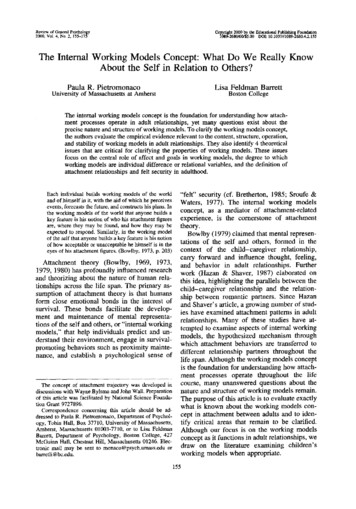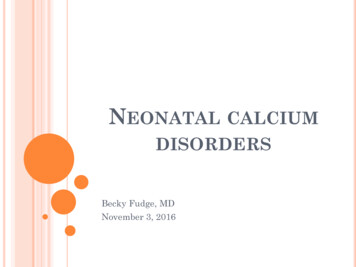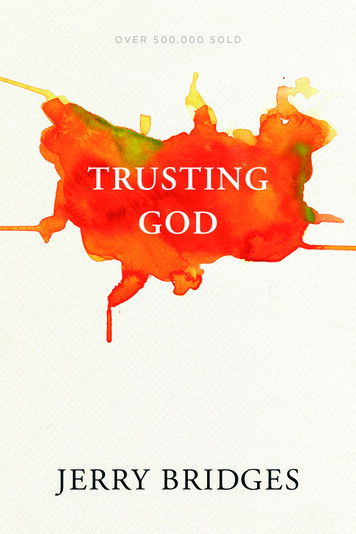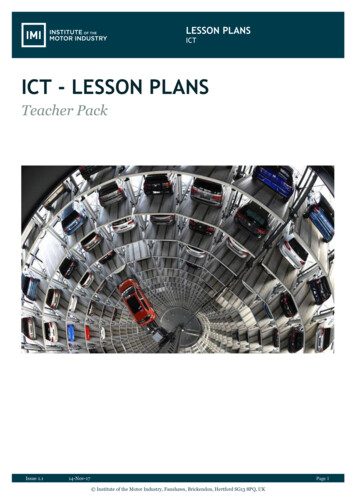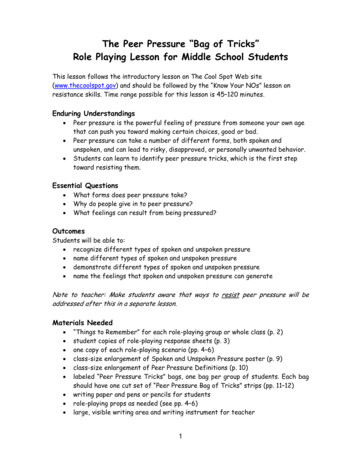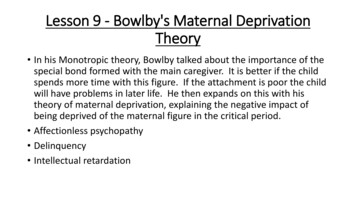
Transcription
Lesson 9 - Bowlby's Maternal DeprivationTheory In his Monotropic theory, Bowlby talked about the importance of thespecial bond formed with the main caregiver. It is better if the childspends more time with this figure. If the attachment is poor the childwill have problems in later life. He then expands on this with histheory of maternal deprivation, explaining the negative impact ofbeing deprived of the maternal figure in the critical period. Affectionless psychopathy Delinquency Intellectual retardation
Bowlby’s Maternal Deprivation Not having a loving relationship with mother in first 2 years can lead to delinquency, affectionlesspsychopathy and intellectual retardation. Study: 44 juvenile delinquents compared with a control group off 44 juveniles not guilty of any crime.14/44 of delinquents were classed as affectionless psychopathy, none of the control group. 12/14 ofaff. Psych. had maternal separation, of the remaining delinquents 5/30 had maternal deprivation, andthe control group only 2/44. This suggests that maternal deprivation leads to antisocial behaviour. The maternal deprivation hypothesis states there is an inborn need for a continuous, caringrelationship and if this is broken it will be detrimental – bed wetting, dwarfism, intellectualretardation and affectionless psychopathy.Evaluation Bowlby studied orphans from the war – they were traumatised and often had poor care so evidenceis flawed as there were other issues not just maternal deprivation. Counter evidence – Lewis replicated 44 juvenile’s study and found maternal deprivation did notpredict criminality of difficulties with relationships. Critical period – evidence to say that damage in this time is not inevitable. Koluchova twins, in carewhen mother died, lived with father and step-mother at 18mnths until 7 yrs. – were abused.Fostered by 9 and by 14 behaviour and intellect were normal. Previous damage had been repaired. Important to distinguish the difference between Deprivation – where bond is broken throughseparation and Privation where no bond was present. Bowlby criticised for focus on separation – more important whether bond is formed. Make notes on other studies: Skuse (1984) 2 sisters/ Tizard & Hodges – children in an institution.
Lesson 10-Effects of Institutionalisation - Romanian Orphans Institutionalisation – living in a hospital or orphanage for long periods of time with little emotionalcare. Studied in Romanian orphanages in 1980’s. Effects can include ‘disinhibited attachment’ – children are equally friendly to strangers and peoplethey know well. (no stranger anxiety). Rutter explained this is because in poor quality institutions suchas Romanian orphanages, child may see 50 carers, not enough to form secure attachments. Studies: (Rutter 2011) followed 165 Romanian orphans adopted in Britain, Bucharest EarlyIntervention Project – who found only 19% of institutional children were securely attached. – makenotes on these studies.Evaluation of studying Romanian orphans'Has led to real life application – improvements in child care in institutions e.g. key worker to developattachments.Fewer extraneous variables – children hadn’t experienced trauma e.g. war beforehand so any effects aredue to institutionalisation rather than other factors.Romanian orphanages are not typical – they were particularly poor with very bad conditions so we can’treally generalise to other orphanages.Ethical issues – in some studies children are not randomly assigned to conditions – they were adoptedor not – this could mean that the child’s temperament was an extraneous variable on whether theywere adopted and the effects it had. However, where random allocation to groups was done – thisraises ethical issues!Long term effects – children have been followed up mid teems, however, it is too soon to discover longterm effects. The children may catch up – socially, emotionally, intellectually in adulthood.
Can children recover from institutionalisation and privation? Quality of care in the institutions – if they have formed an attachment in theinstitution between 7-12 mnths – usually don’t show disinhibited attachment. Studyin a Greek orphanage, each baby was allocated a member of staff who were activelyencouraged to form bonds. Follow up found none of the effects that Tizard andHodge’s study had previously found. Age of child at removal from institute – children adopted younger make betterdevelopment – particularly in language development. Quality of care after institution – if child is placed in a loving environment – morelikely to form a strong attachment with adoptive parents (Koluchova twins study) Experiences in later life – not only early experiences impact on later development. Ifchild has positive experiences at school, in marriages, etc. early damage can bereversed.Study: Quinton & Rutter looked at 2 groups of women, 1 group had been in care, othergroup not. Those that has positive experiences in later life fared better even if they hadbeen in care in their early years.
Lesson 11 - Influence on adult relationshipsShort term effects: Protest, Despair, DetachmentLong term effects: Separation anxiety, Distance, DemandingInternal working model: Bowlby – first relationship with primary attachment figure forms a mentalrepresentation - an internal working model. If their first experience is of a loving relationship – they assume this ishow relationships are meant to be and they will seek this out in future. If bad, they will struggle to formrelationships/or form inappropriate ones.Relationships with Peers (sonot necessarily adultrelationships!) Securely attached infantsgo on to form the bestquality childhoodfriendships. Less likely tobe involved in bullying.Relationship with romantic partnersA study of 40 adult women who had been assessed as children ontheir attachment type, were assessed on their romanticrelationships and friendships. Those who were securely attachedinfants had the best adult friendships and romantic relationships.Insecure resistant – problems maintaining friendships Insecureavoidant struggled with intimacy in romantic relationships.Hazan & Shaver analysed 620 replied to a ‘love quiz’ – it assessed Insecurely attached infants current relationship, general love experiences and attachmenthave friendship difficulties, type.particularly insecureSecurely attached (56%) had good and long lasting romanticresistant who are likely toexperiences.have a lot or argumentswith friends. Insecureavoidant more likely to be Insecure avoidant (25%) revealed jealousy and fear of intimacy.victims of bullying,Insecure resistant (19%) problematic relationshipsinsecure resistant mostlikely to be bullies.Relationships as a parentThe internal workingmodel also affects thechild’s ability to parenttheir own child.Bailey et al (2007) studied99 mothers, comparing theattachments of them totheir children and theirown mothers. They foundsimilar patterns (see studyin ‘Bowlby's monotropictheory hand-out’)
Evaluation of influence of early attachment Studies such as Hazan & Shaver support the internal working model. However,Zimmerman (2000) found little relationship between quality of infant and adolescentattachment. Validity. Most studies use interviews/questionnaires years later – 2 problems: willpeople be honest? Will people accurately remember? Not causality – assumes infant attachment causes adult attachment. But – it’scorrelation (doesn’t’ show cause & effect) so could be alternative explanation e.g.child’s temperament!!! Probabilistic – theory seems likely however, researchers may have exaggerated thesignificance – it could be chance and some people with poor childhood attachmentscan form good adult relationships. Conscious self report vs unconscious internal working model – the working model is‘unconscious’ we are not aware of it so if participants self-report on theirrelationships that is their conscious understanding so not a very accurate record ofthe person’s internal working model.
Hazan & Shaver analysed 620 replied to a 'love quiz' -it assessed current relationship, general love experiences and attachment type. Securely attached (56%) had good and long lasting romantic experiences. Insecure avoidant (25%) revealed jealousy and fear of intimacy. Insecure resistant (19%) problematic relationships Relationships as a .

